|
DAZU (Day 9 - part 2)
Cave of Full Enlightenment:
The cave is 19 feet high, 30 feet wide and 39 feet deep. It houses 52 statues.
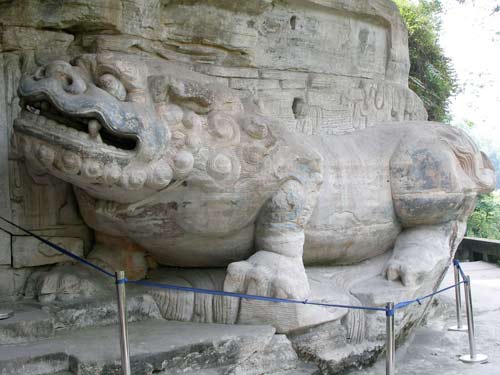
A crouching tiger guards the entrance.
On the main wall are three sitting Buddhas. A bodhisattva is kneeling before them, symbolizing the sincerity to consult and learn from them. In Buddhism, a bodhisattva is the name given to anyone who, motivated by great compassion, wishes to attain complete enlightenment in order to be of benefit to all sentient beings.
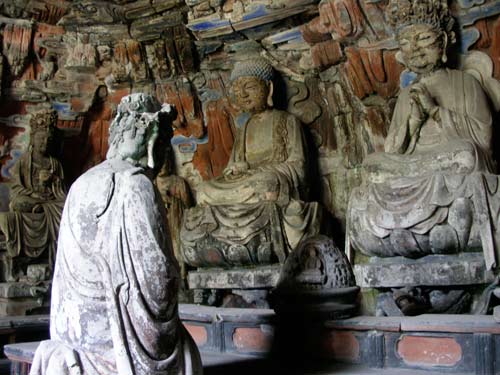
The Buddhas and bodhisattva
This 100-foot wall contains 10 groups of carving, starting with the Tameless Buffalo at the beginning and finishing with the Herdsman and Buffalo in Full Enlightement. Basically, the buffalo represents a man's heart, and the herdsman represents a person who practices Buddhism. The progression shows the gradual process of taming mental activities of Buddhists.
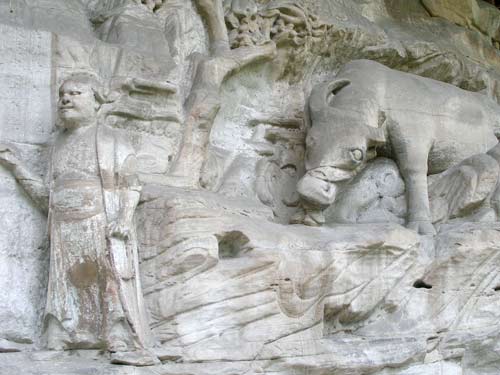
Herdsman and buffalo are not together. Hence the man's heart is still wild.

The taming of the buffalo. In the end, everyone is happy.
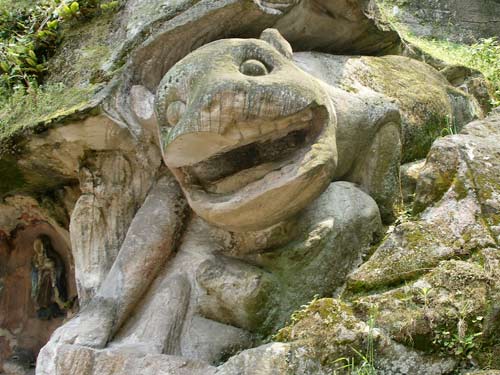
An animal emerges from a crevice on our way to the next set of carvings.
Niche of Guardians of Buddhist Law:
This 41-foot long, 14-foot tall niche houses 33 statues. In the top row are six gods; in the middle row are the nine guardians of Buddhist law; and on the bottow row are seven ghosts. The duty of the guardians is to protect this site and subdue monsters.

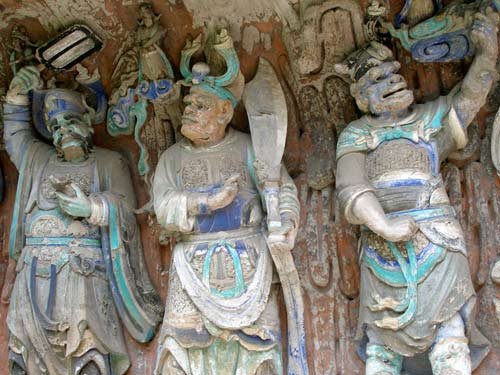
The fearsome-looking guardians
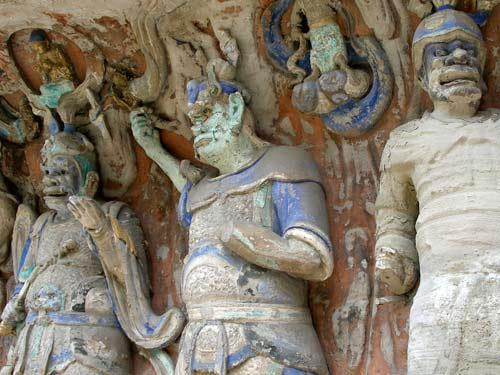
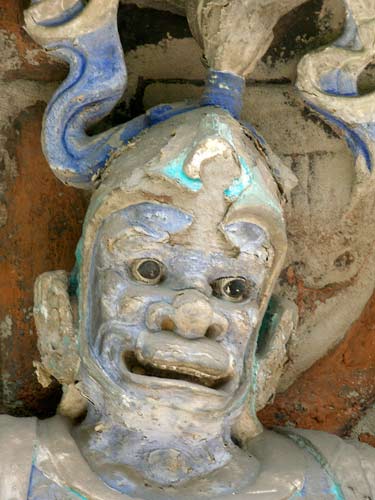
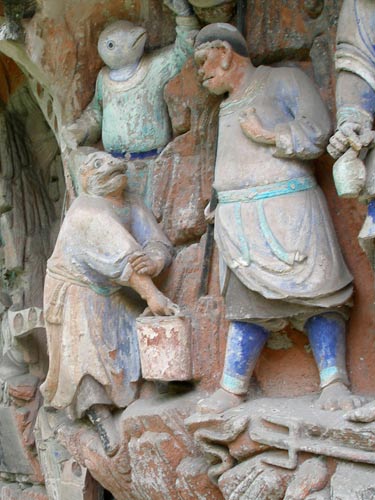
Buddhist Wheel of Life:
This niche houses 90 statues of people and 24 statues of animal. Anicca holds the wheel of life in his arms. Six reincarnations of all the living creatures are displayed in the wheel. The scene vividly shows Buddhist karma (one's actions) and retribution (the payment for that action).
The concept of impermanence is known in Buddhism as anicca. Basically everything is limited to a certain duration and liable to disappear. Nothing is permanent. Existence is a flux. According to the teachings of the Buddha, life is comparable to a river. It is a successive series of different moments, joining together to give the impression of one continuous flow. The river of yesterday is not the same as the river of today.
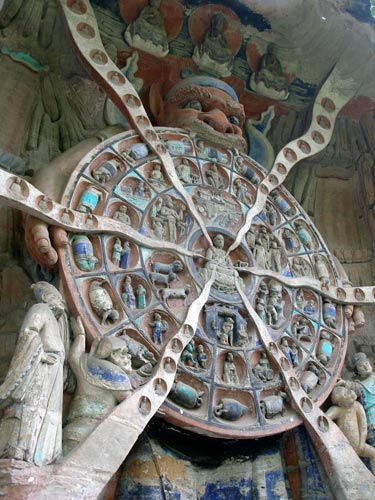

To the right is a scene from hell, where there is lots of suffering and a person is being eaten by ghosts.
The mouse represents 'desire'. Until one gets rid of this desire, one can never truly be happy.
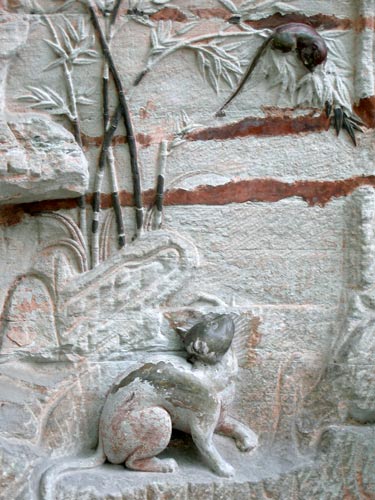
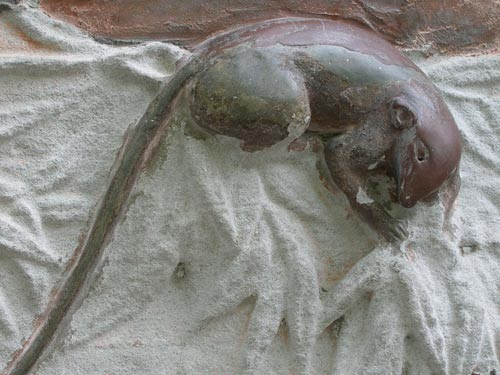
Three Saints of Huayan School of Buddhism:
This niche contains 119 statues. The large 23-foot tall statues are (from left to right): Manjusri Bodhisattva, Vairocana Buddha and Samantabhadra Bodhisattva. The back wall is lined with 88 Buddhas.
Manjusri is a bodhisattva associated with wisdom, doctrine and awareness. Samantabhadra is a bodhisattva associated with Buddhist practice and meditation. Vairocana is one of the Five Wisdom (or Dhyani) Buddhas. Each represents a different aspect of enlightened consciousness to aid in spiritual transformation.
Established during the end of the Sui and beginning of the Tang Dynasties (600 - 700), the Huayan school (or Flower Garland, suggesting the crowning glory of profound understanding) of Buddhist philosophy ended up having profound impact on the philosophical attitudes of all of East Asian Buddhism.
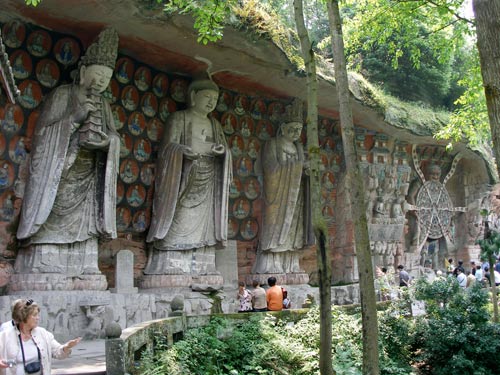
The figures are carved back into the rock so that the overhanging ledges can protect them from the rain.
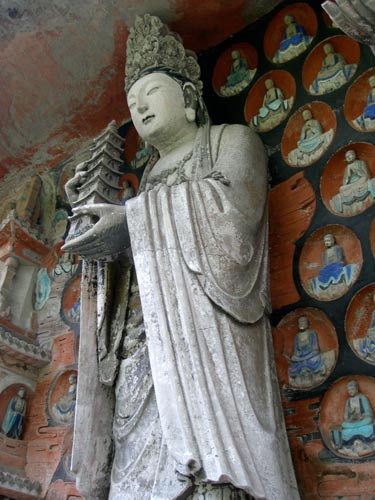
The stone pagoda held in the hands of Manjusri Bodhisattva weighs about 100 pounds. It has stood steadily for more than 800 years just because the Kasaya (robes of Buddhist monks), draping from the elbows down to the feet, supports the arms.

Vairocana represents the wisdom of shunyata (emptiness).
Hand gestures called mudra are very important in Buddhism. They are meant to express different ideas such as teaching, fearlessness & granting protection, confidence, welcoming, touching the earth, charity, enlightenment, meditation, and so on.

Buddha sits on a lotus flower.
Different postures represent different stages or aspects of the Buddha's life: standing, sitting lotus position (cross-legged), sitting half-lotus position (one leg hangs down to the ground), and lying down. The two lotus positions symbolize that Buddha, like the lotus plant, emerged from the mud to achieve enlightenment. The reclining Buddha usually represents his death, passing into nirvana and escaping the tedious cycle of life, death, and rebirth.
Avalokitesvara with Thousand Hands:
There are 1,007 hands spread over an area of 950 square feet. Avalokitesvara is a bodhisattva who embodies the compassion of all Buddhas. Supposedly he has made a vow to listen to the prayers of all sentient beings in times of difficulty, and to postpone his own Buddhahood until he has assisted every being on Earth in achieving nirvana (the state of being free from suffering and the cycle of rebirth).

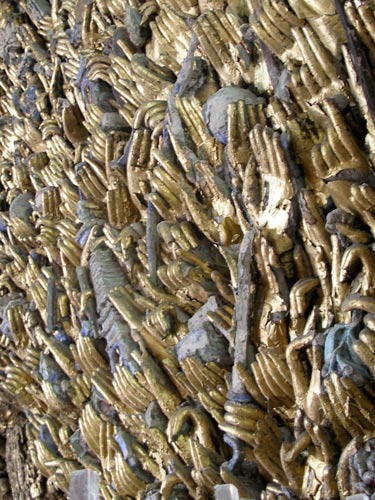
Each hand has an eye in the palm.
Sakyamuni enters Nirvana:
Also called Sleeping Buddha, the niche contains 37 statues. The Buddha statue is over 100 feet long, and only his upper body is visible. The ancient sculptors left room for viewers to imagine how magnificent the Buddha is. This is rarely seen in other grottos in China.
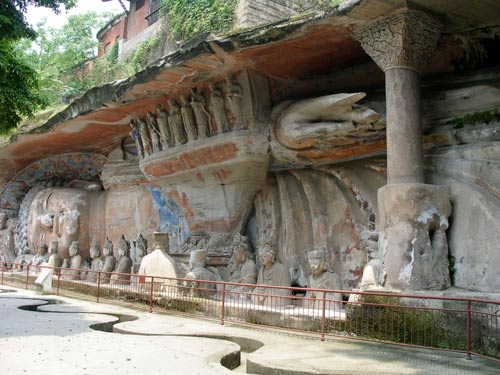
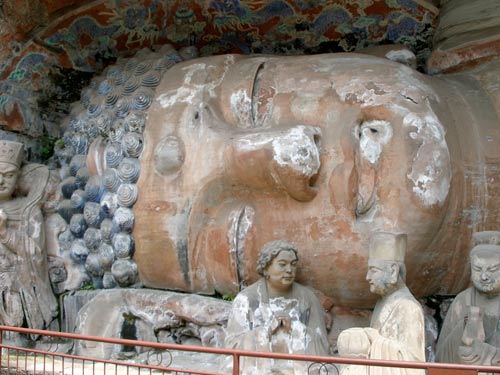
Common physical traits of the Buddha:
- The earlobes are elongated, partly to indicate he is all-hearing and partly as a reminder of the heavy earrings (worn by royalty) that weighed them down before Siddhartha renounced material things to seek enlightenment.
- His head is usually enlarged (sometimes by a large bump on top) to symbolize wisdom; a jewel in the bump denotes brilliance.
- The hair is generally curly. According to legend, after shearing off his long princely locks, Siddhartha then had a head of short, fine curls, which was not a common look in Asia and thus a distinguishing sign.
- A dot or protrusion in the center of the forehead represents power or an all-seeing eye.
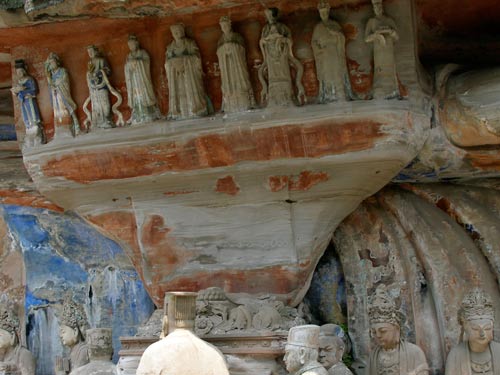
Nine Dragons Bathing the Prince:
Nine dragons in the wall spit out water to bathe Sakyamuni when he was born as a prince. Originally this place was a natural drain of the water from the Saint Sign Pond above the cliff, showing the ingenuity of the sculptors.
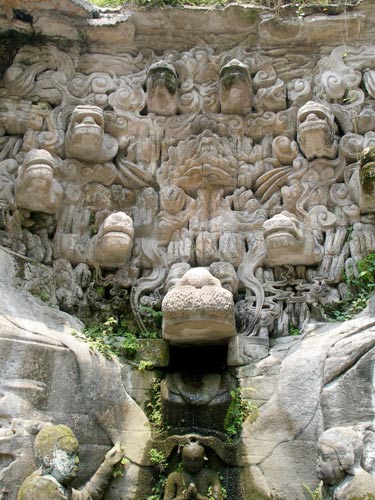
Sakyamuni is seated in the basin below.
Niche of Peacock King Sutra:
The king is seated on a lotus throne carried by a peacock. In Asia, the feathers of the peacock are considered auspicious and protective.
A sutra literally means a rope or thread that holds things together, and metaphorically refers to a saying or a collection of sayings in the form of a manual. In Buddhism, the term mostly refers to the records of the oral teachings of the Buddha.
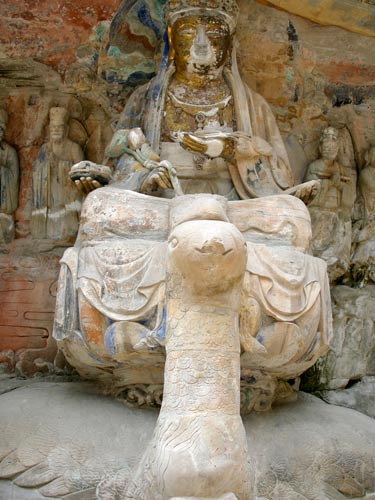
Cave of Vairocana Buddha:
The cave is filled with 287 statues, with several being damaged as the result of a collapse many years ago. Buddha Vairocana (the same one from the Three Saints of Huayan School of Buddhism) is explaining dharma while the other statues listen attentively.
Dharma is a spiritual term that means one's righteous duty or law. In Buddhism, it can also be translated as the teachings of the Buddha. It is used to explain the "higher truth" or ultimate reality of the universe.
The next two sections, Parents & Children (describing family love and interaction), are found only here. Other temples focus exclusively on the Buddha.
Niche of Parental Love Sutra:
This large niche (23 feet tall by 47 feet long) is home to 44 statues. On the upper level are seven Buddhist busts. In the lower tier are 10 groups of carvings depicting parental love in bringing up children, with plots linking to each other as in a picture book.

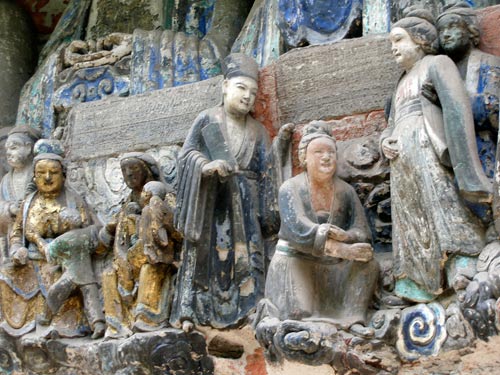
"Praying to Buddha for a son" is the name of this group (on the right), the first in the series.
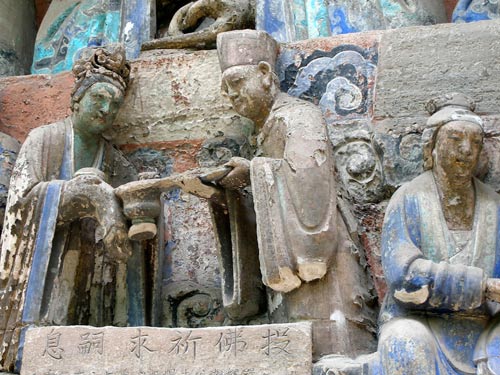
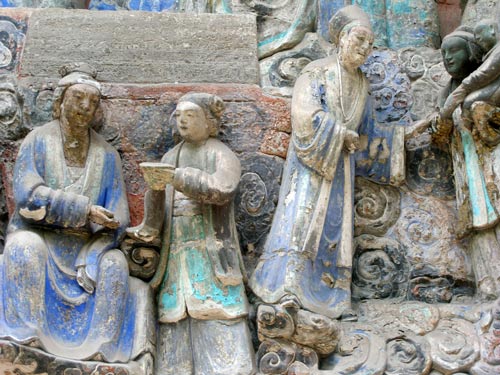
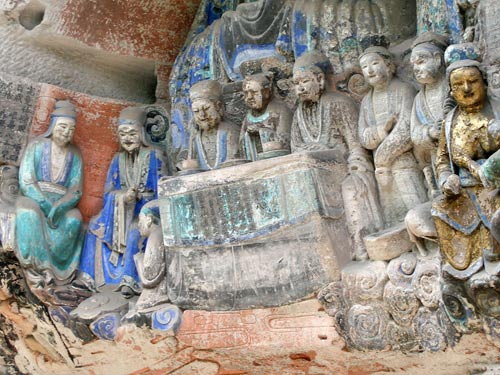
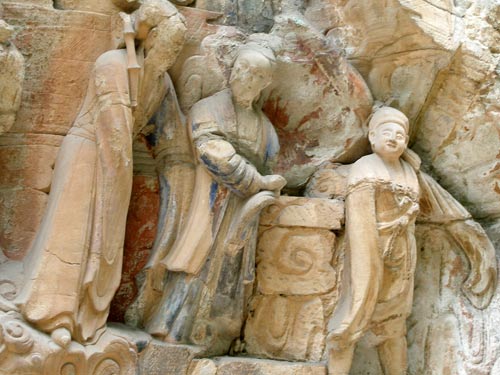
The old parents watch as the son leaves home.
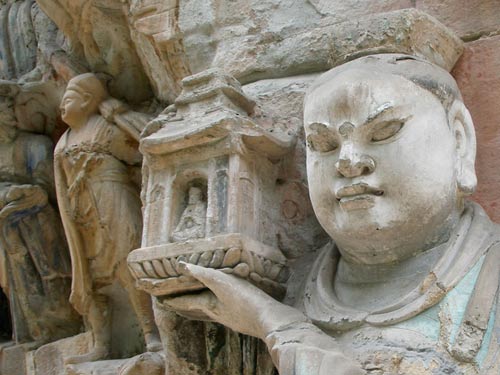
Sakyamuni's Filial Piety:
68 statues tell the stories in this niche. In the middle is a bust of Sakyamuni (the Buddha), and on both its sides are 12 groups of statues depicting his practice of Buddhism and showing filial piety (the quality of being dutiful from a son or daughter) in both his previous and present life. It shows his spirit of self-sacrifice for his parents. Some of his deeds were offering himself to a hungry tiger so it wouldn't eat his parents, and cutting his eyes out for medicine.
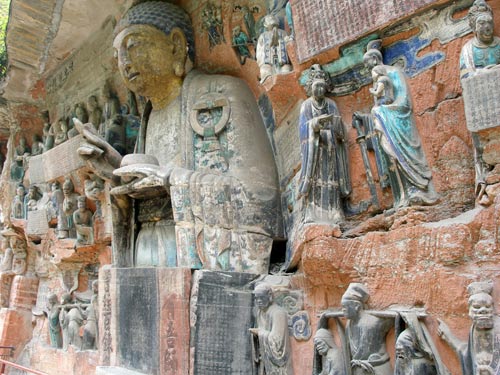
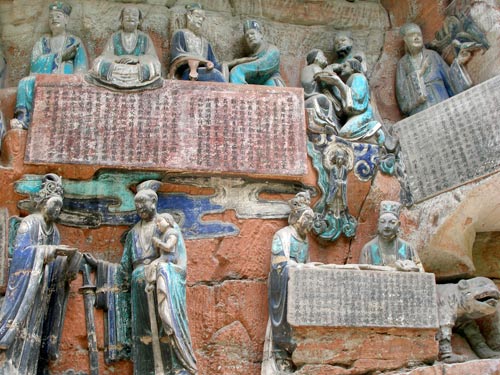

Expressing devotion
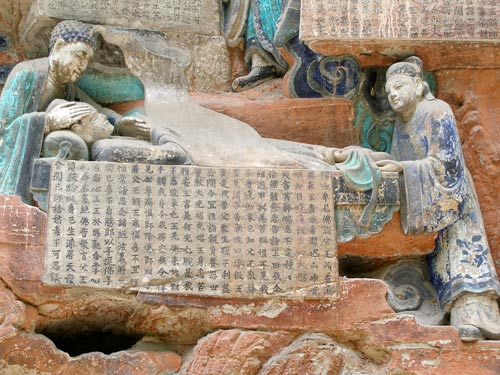
Caring for the sick and elderly
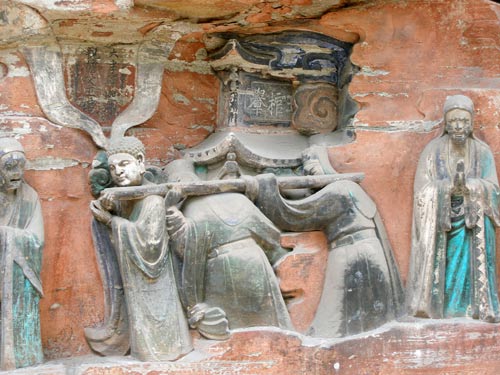

Carrying his elderly parents
|
|

